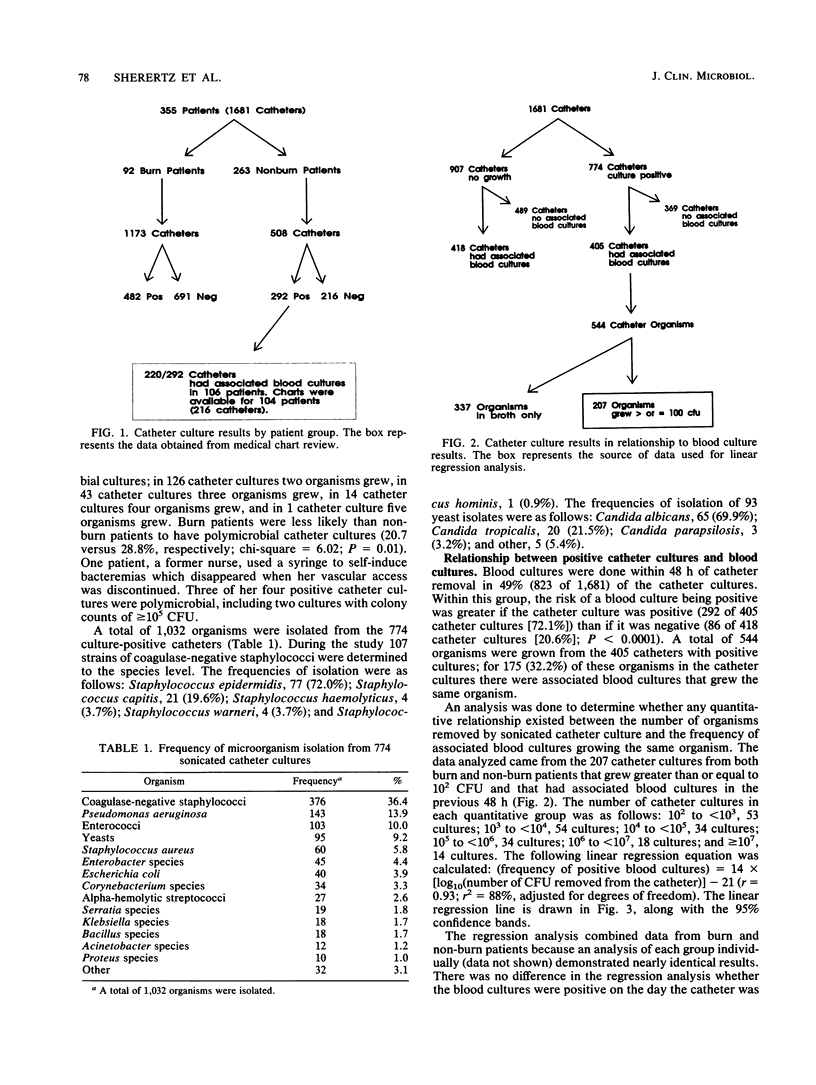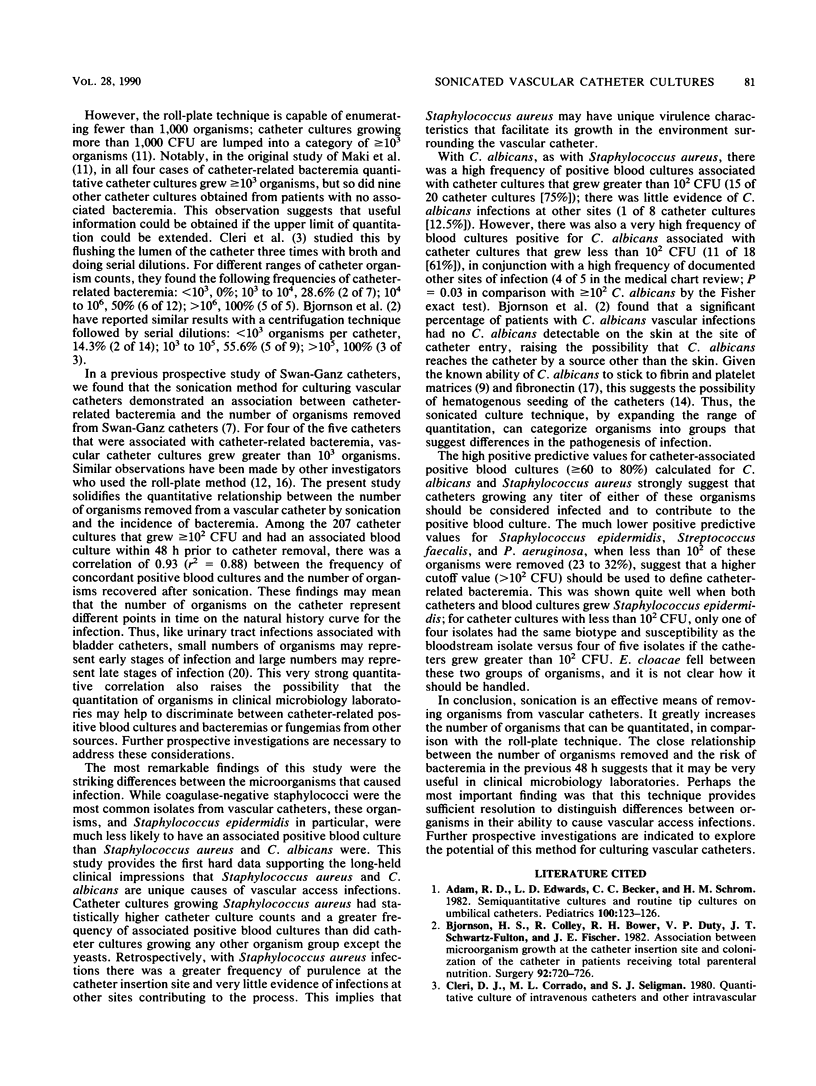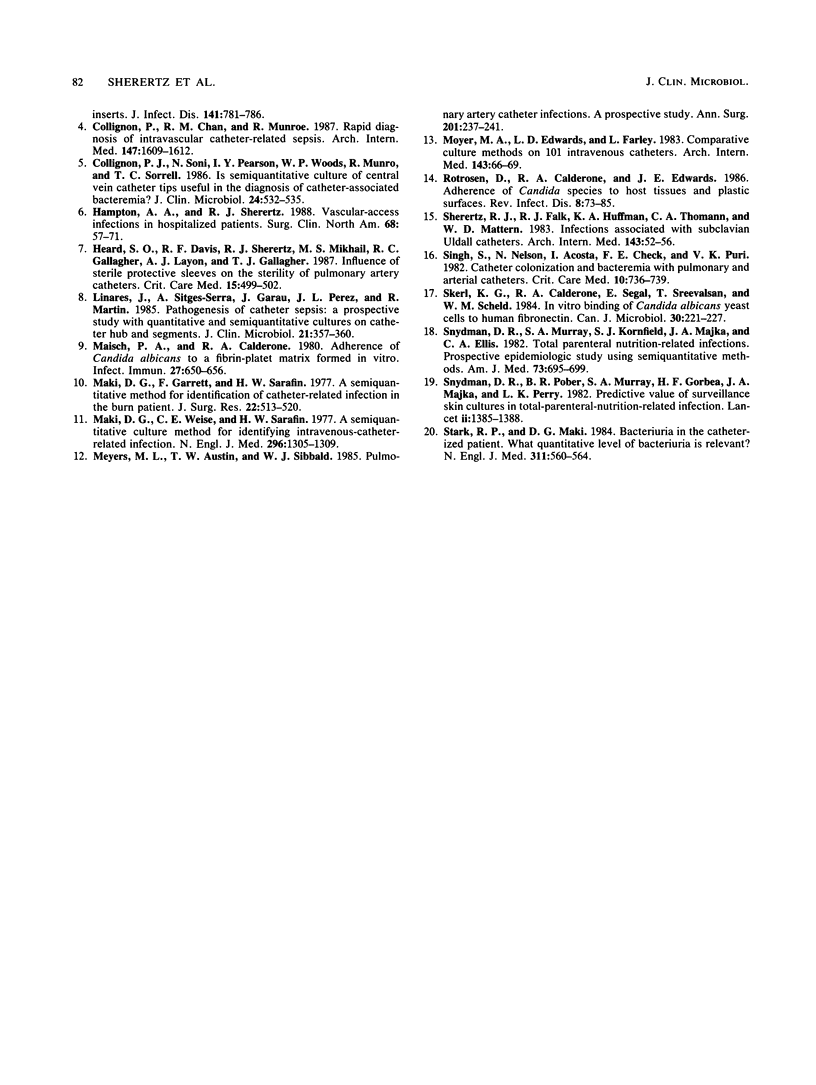Abstract
Using a quantitative sonication method, we cultured 1,681 consecutive vascular catheters submitted to a clinical microbiology laboratory in a 36-month period. A total of 46% of the cultures were positive; the most common organisms isolated were coagulase-negative staphylococci (36.4%), Pseudomonas aeruginosa (13.9%), enterococci (10.0%), yeasts (9.2%), Staphylococcus aureus (5.8%), and Enterobacter species (4.4%). The frequencies of positive blood cultures within 48 h prior to a positive catheter culture result were as follows: Candida albicans (68.4%), S. aureus (60%), Enterobacter cloacae (42.9%), Staphylococcus epidermidis (32.1%), P. aeruginosa (27.7%), and enterococci (23.3%). The sonication method allowed quantification of the number of CFU removed from a catheter for between 10(2) and 10(7) CFU. For catheter cultures in which greater than or equal to 10(2) CFU grew, a linear regression equation could be calculated: (risk of positive blood culture for the same organism) = 14 [log10 (number of organisms removed from the catheter)] -21 (r = 0.93). For catheter cultures in which less than 10(2) CFU grew, positive blood cultures for the same organism were strongly associated with a proven infection at a site distant from the catheter (P = 0.001) or probable contamination (S. epidermidis). Our findings indicate that this technique has considerable potential for use in clinical microbiology laboratories to aid in the diagnosis of vascular catheter infections and for clinical investigations into the pathogenesis of these infections.
Full text
PDF






Selected References
These references are in PubMed. This may not be the complete list of references from this article.
- Adam R. D., Edwards L. D., Becker C. C., Schrom H. M. Semiquantitative cultures and routine tip cultures on umbilical catheters. J Pediatr. 1982 Jan;100(1):123–126. doi: 10.1016/s0022-3476(82)80251-5. [DOI] [PubMed] [Google Scholar]
- Bjornson H. S., Colley R., Bower R. H., Duty V. P., Schwartz-Fulton J. T., Fischer J. E. Association between microorganism growth at the catheter insertion site and colonization of the catheter in patients receiving total parenteral nutrition. Surgery. 1982 Oct;92(4):720–727. [PubMed] [Google Scholar]
- Collignon P. J., Soni N., Pearson I. Y., Woods W. P., Munro R., Sorrell T. C. Is semiquantitative culture of central vein catheter tips useful in the diagnosis of catheter-associated bacteremia? J Clin Microbiol. 1986 Oct;24(4):532–535. doi: 10.1128/jcm.24.4.532-535.1986. [DOI] [PMC free article] [PubMed] [Google Scholar]
- Collignon P., Chan R., Munro R. Rapid diagnosis of intravascular catheter-related sepsis. Arch Intern Med. 1987 Sep;147(9):1609–1612. [PubMed] [Google Scholar]
- Hampton A. A., Sherertz R. J. Vascular-access infections in hospitalized patients. Surg Clin North Am. 1988 Feb;68(1):57–71. doi: 10.1016/s0039-6109(16)44432-4. [DOI] [PubMed] [Google Scholar]
- Heard S. O., Davis R. F., Sherertz R. J., Mikhail M. S., Gallagher R. C., Layon A. J., Gallagher T. J. Influence of sterile protective sleeves on the sterility of pulmonary artery catheters. Crit Care Med. 1987 May;15(5):499–502. doi: 10.1097/00003246-198705000-00009. [DOI] [PubMed] [Google Scholar]
- Liñares J., Sitges-Serra A., Garau J., Pérez J. L., Martín R. Pathogenesis of catheter sepsis: a prospective study with quantitative and semiquantitative cultures of catheter hub and segments. J Clin Microbiol. 1985 Mar;21(3):357–360. doi: 10.1128/jcm.21.3.357-360.1985. [DOI] [PMC free article] [PubMed] [Google Scholar]
- Maisch P. A., Calderone R. A. Adherence of Candida albicans to a fibrin-platelet matrix formed in vitro. Infect Immun. 1980 Feb;27(2):650–656. doi: 10.1128/iai.27.2.650-656.1980. [DOI] [PMC free article] [PubMed] [Google Scholar]
- Maki D. G., Jarrett F., Sarafin H. W. A semiquantitative culture method for identification of catheter-related infection in the burn patient. J Surg Res. 1977 May;22(5):513–520. doi: 10.1016/0022-4804(77)90034-8. [DOI] [PubMed] [Google Scholar]
- Maki D. G., Weise C. E., Sarafin H. W. A semiquantitative culture method for identifying intravenous-catheter-related infection. N Engl J Med. 1977 Jun 9;296(23):1305–1309. doi: 10.1056/NEJM197706092962301. [DOI] [PubMed] [Google Scholar]
- Moyer M. A., Edwards L. D., Farley L. Comparative culture methods on 101 intravenous catheters. Routine, semiquantitative, and blood cultures. Arch Intern Med. 1983 Jan;143(1):66–69. [PubMed] [Google Scholar]
- Myers M. L., Austin T. W., Sibbald W. J. Pulmonary artery catheter infections. A prospective study. Ann Surg. 1985 Feb;201(2):237–241. doi: 10.1097/00000658-198502000-00018. [DOI] [PMC free article] [PubMed] [Google Scholar]
- Rotrosen D., Calderone R. A., Edwards J. E., Jr Adherence of Candida species to host tissues and plastic surfaces. Rev Infect Dis. 1986 Jan-Feb;8(1):73–85. doi: 10.1093/clinids/8.1.73. [DOI] [PubMed] [Google Scholar]
- Sherertz R. J., Falk R. J., Huffman K. A., Thomann C. A., Mattern W. D. Infections associated with subclavian Uldall catheters. Arch Intern Med. 1983 Jan;143(1):52–56. [PubMed] [Google Scholar]
- Singh S., Nelson N., Acosta I., Check F. E., Puri V. K. Catheter colonization and bacteremia with pulmonary and arterial catheters. Crit Care Med. 1982 Nov;10(11):736–739. doi: 10.1097/00003246-198211000-00007. [DOI] [PubMed] [Google Scholar]
- Skerl K. G., Calderone R. A., Segal E., Sreevalsan T., Scheld W. M. In vitro binding of Candida albicans yeast cells to human fibronectin. Can J Microbiol. 1984 Feb;30(2):221–227. doi: 10.1139/m84-033. [DOI] [PubMed] [Google Scholar]
- Snydman D. R., Gorbea H. F., Pober B. R., Majka J. A., Murray S. A., Perry L. K. Predictive value of surveillance skin cultures in total-parenteral-nutrition-related infection. Lancet. 1982 Dec 18;2(8312):1385–1388. doi: 10.1016/s0140-6736(82)91281-8. [DOI] [PubMed] [Google Scholar]
- Snydman D. R., Murray S. A., Kornfeld S. J., Majka J. A., Ellis C. A. Total parenteral nutrition-related infections. Prospective epidemiologic study using semiquantitative methods. Am J Med. 1982 Nov;73(5):695–699. doi: 10.1016/0002-9343(82)90412-0. [DOI] [PubMed] [Google Scholar]
- Stark R. P., Maki D. G. Bacteriuria in the catheterized patient. What quantitative level of bacteriuria is relevant? N Engl J Med. 1984 Aug 30;311(9):560–564. doi: 10.1056/NEJM198408303110903. [DOI] [PubMed] [Google Scholar]


